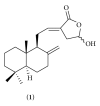Antimicrobial activity of coronarin D and its synergistic potential with antibiotics
- PMID: 24949458
- PMCID: PMC4053275
- DOI: 10.1155/2014/581985
Antimicrobial activity of coronarin D and its synergistic potential with antibiotics
Abstract
Coronarin D is a labdane-type diterpene from the rhizomes of Hedychium coronarium. In the view of our ongoing effort to explore its novel biological activity, antimicrobial activity study of coronarin D was performed. The results showed that coronarin D was active against tested Gram-positive bacteria, inactive for tested Gram-negative bacteria, and weakly active against tested fungi. The antibacterial effect of the combination of coronarin D with nine classical antibiotics against four Gram-positive bacteria was also evaluated. The fractional inhibitory concentration indices (FICI) of coronarin D-antibiotics combinations, calculated from the checkerboard assay, were used as synergism indicator. Out of 36 combinations, 47% showed total synergism, 33% had partial synergistic interaction, 17% showed no effect, and 3% showed antagonism. By combination with coronarin D at concentration of 0.25 minimal inhibitory concentration (MIC), the activities of antibiotics were boosted to 4- to 128-fold. These finding suggested an attractive approach to combat the infectious diseases by using coronarin D-antibiotic drug combination.
Figures
Similar articles
-
Antimicrobial activity of Ganoderma lucidum extract alone and in combination with some antibiotics.Arch Pharm Res. 1994 Dec;17(6):438-42. doi: 10.1007/BF02979122. Arch Pharm Res. 1994. PMID: 10319155
-
Synergistic antimicrobial activity of combinations of sanguinarine and EDTA with vancomycin against multidrug resistant bacteria.Drug Metab Lett. 2014;8(2):119-28. doi: 10.2174/187231280802150212100742. Drug Metab Lett. 2014. PMID: 25692301
-
Synergistic activity of doped zinc oxide nanoparticles with antibiotics: ciprofloxacin, ampicillin, fluconazole and amphotericin B against pathogenic microorganisms.An Acad Bras Cienc. 2016;88(3 Suppl):1689-1698. doi: 10.1590/0001-3765201620150713. Epub 2016 Oct 10. An Acad Bras Cienc. 2016. PMID: 27737336
-
Antibacterial activity of Thymus maroccanus and Thymus broussonetii essential oils against nosocomial infection - bacteria and their synergistic potential with antibiotics.Phytomedicine. 2012 Mar 15;19(5):464-71. doi: 10.1016/j.phymed.2011.12.003. Epub 2012 Jan 17. Phytomedicine. 2012. PMID: 22257599
-
Anticancer activities and mechanism of action of the labdane diterpene coronarin D.Pathol Res Pract. 2020 Jun;216(6):152946. doi: 10.1016/j.prp.2020.152946. Epub 2020 Apr 3. Pathol Res Pract. 2020. PMID: 32334892 Review.
Cited by
-
Synergistic combination of violacein and azoles that leads to enhanced killing of major human pathogenic dermatophytic fungi Trichophyton rubrum.Front Cell Infect Microbiol. 2015 Aug 11;5:57. doi: 10.3389/fcimb.2015.00057. eCollection 2015. Front Cell Infect Microbiol. 2015. Retraction in: Front Cell Infect Microbiol. 2017 Nov 17;7:496. doi: 10.3389/fcimb.2017.00496. PMID: 26322275 Free PMC article. Retracted.
-
Synergism of Plant Compound With Traditional Antimicrobials Against Streptococcus spp. Isolated From Bovine Mastitis.Front Microbiol. 2018 Jun 6;9:1203. doi: 10.3389/fmicb.2018.01203. eCollection 2018. Front Microbiol. 2018. PMID: 29928266 Free PMC article.
-
Diterpene Coronarin Attenuates Lipopolysaccharide-Induced Acute Lung Injury in Both In Vivo and In Vitro Models.Appl Biochem Biotechnol. 2024 Jul;196(7):4140-4155. doi: 10.1007/s12010-023-04711-7. Appl Biochem Biotechnol. 2024. Retraction in: Appl Biochem Biotechnol. 2024 Nov;196(11):8429. doi: 10.1007/s12010-024-05080-5. PMID: 37906408 Retracted.
-
JNK Inactivation Induces Polyploidy and Drug-Resistance in Coronarin D-Treated Osteosarcoma Cells.Molecules. 2018 Aug 23;23(9):2121. doi: 10.3390/molecules23092121. Molecules. 2018. PMID: 30142914 Free PMC article.
-
Coronarin D induces reactive oxygen species-mediated cell death in human nasopharyngeal cancer cells through inhibition of p38 MAPK and activation of JNK.Oncotarget. 2017 Nov 14;8(64):108006-108019. doi: 10.18632/oncotarget.22444. eCollection 2017 Dec 8. Oncotarget. 2017. PMID: 29296219 Free PMC article.
References
-
- Jamison DT, Breman JG, Measham AR, et al. Disease Control Priorities in Developing Countries. Washington, DC, USA: World Bank; 2006. - PubMed
-
- Leoung GS, Mills J. Opportunistic Infections in Patients with the Acquired Immunodeficiency Syndrome. New York, NY, USA: Marcel Dekker; 1989.
-
- Inweregbu K, Dave J, Pittard A. Nosocomial infections. Continuing Education in Anaesthesia, Critical Care and Pain. 2005;5(1):14–17.
-
- Mack D, Davies AP, Harris LG, Rohde H, Horstkotte MA, Knobloch JK-M. Microbial interactions in Staphylococcus epidermidis biofilms. Analytical and Bioanalytical Chemistry. 2007;387(2):399–408. - PubMed
MeSH terms
Substances
LinkOut - more resources
Full Text Sources
Other Literature Sources
Molecular Biology Databases



